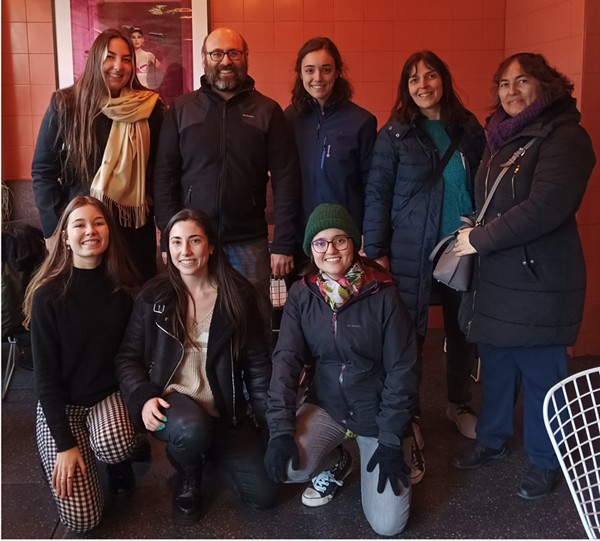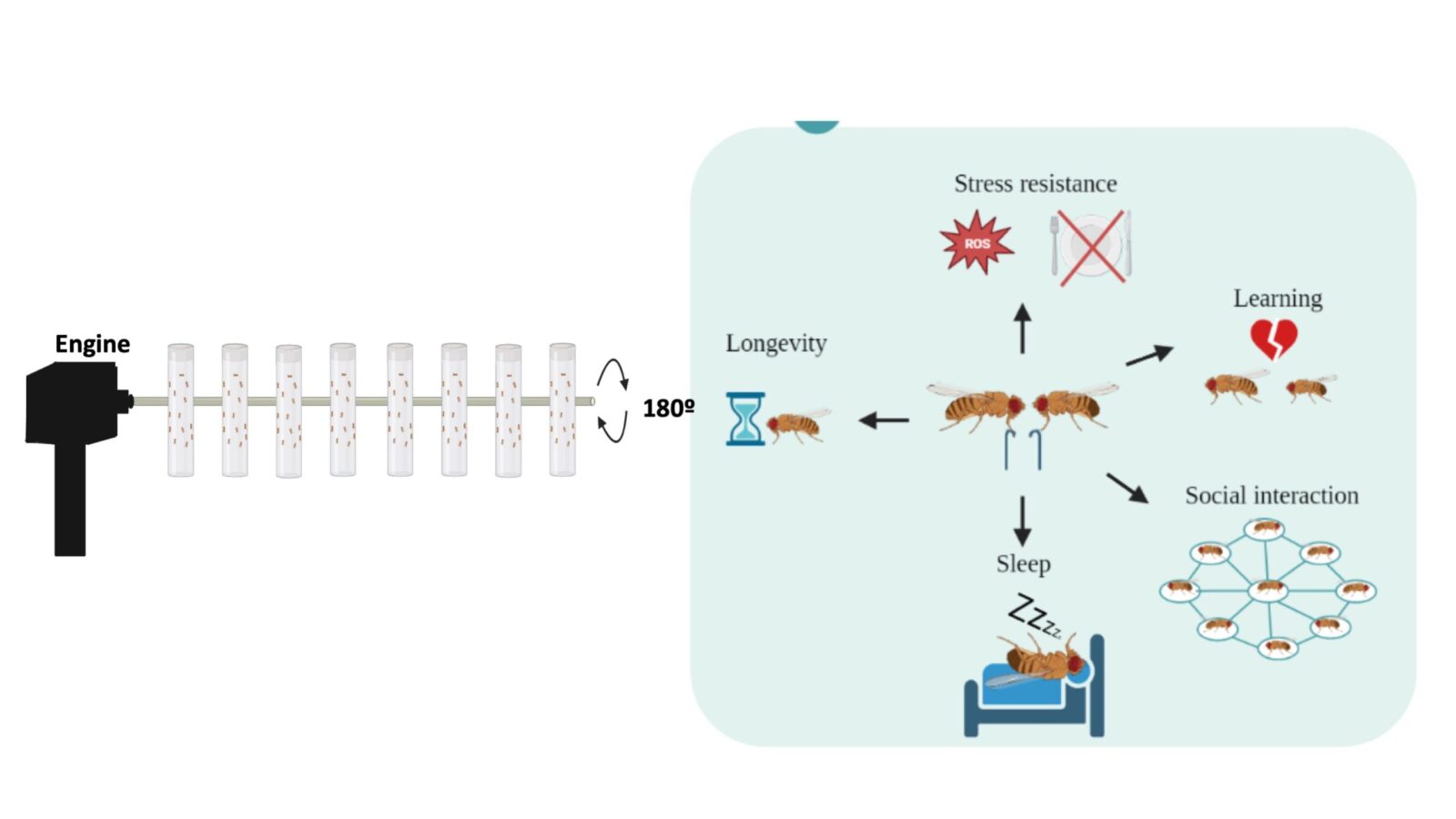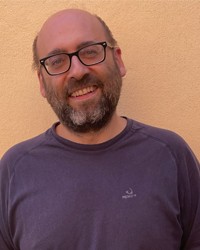LABORATORIES
Molecular physiology of behavior
Molecular physiology of behavior
Research
Team
Publications
Contact
Others
Research

Lines of investigation
Line 1.- Functions of the Drosophila PTTH/Torso neurohormonal axis in adult physiology
The neuroendocrine axis responsible for the juvenile-adult transition is likely already present in the ancestor of vertebrates and insects. In Drosophila the ptth gene (and its torso receptor) has functions equivalent to vertebrate GnRH (and its GnRHR receptor) during this transition. However, in both cases ptth and GnRH are expressed in the adult brain with functions not well described. Our objective is to study these functions in Drosophila, determining the cellular networks used by PTTH/Torso to regulate systemic physiological processes and the transcriptional profile in the target tissues of ptth mutant animals.

Fig 1.- Expression of ptth in the brain of the larva, in young flies recently emerged from the pupa and in aged animals.
Line 2.- Genomic bases of long-term memory
Long-term memory formation requires changes in transcriptional activity. Given the conservation of the molecular mechanisms of memory known up to now between the different species, we will use the fruit fly together with the genetic and -omics tools available to answer two questions about memory. On the one hand, to study whether social interaction causes a specific memory that causes changes in behavior. On the other, to determine the transcriptional changes during memory reactivation, functionally testing the most relevant candidate genes. The results obtained will allow us to know if there is a conserved pattern between types of memory or even between species.

Figure 2.- The learning paradigms used in the laboratory. A male, after unsuccessfully courting a female, when facing the stimulus (female) again decreases his courtship time. In a memory mutant the fly courts like the first time. In the social interaction test, we compare flies that have grown social (social interaction) with flies grown in solitude (isolation).
Line 3.- Effect of healthy aging on cognitive abilities
Given the increase in neurodegenerative diseases and cognitive problems that accompany an increasingly aging population, one of the objectives of our society is to maintain a better quality of life in old age. Moderate exercise has been shown to improve several physiological aspects altered by age. This line of research aims to establish Drosophila as a model to study at the molecular level the effect of exercise on brain function during aging. We are also interested in studying the functional consequences of altering PTTH levels during the decline caused by age, paying attention to gender differences. We hope that our results will allow us to explore new ways to counteract the effect of aging in humans.

Figure 3.- The apparatus used to exercise flies for 5 days. Subsequently, the animals are left to age for 25 days and it is tested how different cognitive and physiological aspects improve: learning, social interaction, sleep, resistance to stress and longevity.
Team

Francisco A. Martín Castro
Principal Investigator

Maria del Carmen Rodriguez Navas
Laboratory technician

Esther Seco Martín
Laboratory technician

Celia González Barredo
Predoctoral researcher, UAM (FPI- UAM)

Beatriz Gil Martí
Predoctoral researcher, UAM (FPI- UAM)

Sara Piña Flores
Predoctoral researcher, UAM (FPU)

Julia Isidro Mezcua
TFM student, UAM (JAE intro-CSIC)

Irene Camacho Agudo
TFG student, UCM
Publications
Publications
- A simplified Courtship Conditioning protocol to test learning and memory in Drosophila. Gil-Marti B*, Barredo CG, Pina-Flores S, Poza-Rodriguez A, Treves G, Rodriguez-Navas C, Camacho L, Pérez-Serna A, Jimenez I, Brazales L, Fernandez J, Martín FA* (2023). STAR protocols 4:101572; DOI: 10.1016/j.xpro.2022.101572
- Alignment between glioblastoma internal clock and environmental cues ameliorates survival in Drosophila. Jarabo P, Barredo CG, De Pablo C, Casas-Tinto S*, Martín FA* (2022). Communications Biology 5, 644; DOI: 10.1038/s42003-022-03600-9
- The elusive transcriptional memory trace. Gil-Marti B, Barredo CG, Pina-Flores S, Trejo JL, Turiegano E, Martín FA* (2022). Oxford Open Neuroscience. Volume 1, kvac008; DOI: 10.1093/oons/kvac008.
- Editorial: Behavior-Driven Changes in Gene Expression. Ferrus A*, Martín FA*, Tuesta LM*, Martín-Peña A* (2022) Frontiers in Behavioral Neuroscience 16:839395.
- Barredo CG, Gil-Marti B, Deveci D, Romero NM*, Martín FA* (2021). Timing the juvenile-adult neurohormonal transition: functions and evolution. Frontiers in Endocrinology 11:602285
- Insulin signaling mediates neurodegeneration in glioma. Jarabo P, De Pablo C, Herranz H, Martín FA*, Casas-Tinto S* (2021). Life Science Alliance 4 (3) e202000693; DOI: 10.26508/lsa.
- Glioblastoma models in Drosophila melanogaster. Losada-Pérez M*, Jarabo P*, Martín FA*, Casas-Tintó S* (2020). In: eLS. John Wiley & Sons, Ltd:Chichester. DOI: 10.1002/9780470015902.a0022540.pub2
- AstA signaling functions as an evolutionary conserved mechanism timing juvenile to adult transition. Deveci D, Martín FA, Leopold P, Romero NM (2019). Current Biology 29, 813-822. DOI 10.1016/j.cub.2019.01.053
- Prothoracicotropic hormone modulates environmental adaptive plasticity through the control of developmental timing. Shimell MJ, Pan X, Martín FA, Ghosh AC, Leopold L, O’Connor MB, Romero NM (2018). Development 145: dev159699. DOI: 10.1242/dev.159699
- Neurogenetics of Drosophila circadian clock: expect the unexpected. Jarabo P, Martín FA* (2017). Journal of Neurogenetics 4:1-16. DOI: 10.1080/01677063.2017.1370466
- Ligand independent requirements of steroid receptors EcR and USP for cell survival. Mansilla A*, Martín FA*, Martín D, Ferrús A (2016). Cell Death and Differentiation 23:405-16. DOI: 10.1038/cdd.2015.108.
Contact
Where to find us
Behavioral Molecular Physiology Group. Laboratory C-22
Instituto Cajal CSIC. Avda. Doctor Arce, 37. 28002. Madrid
Call us
Phone number:
Write us
Email address:
Others
Granted projects
- Memory mark for learning coding. Project PID: 10560 (EASI-Genomics; European Genomics Infrastructure – H2020). Duration: 2020-2021.
- Functions of the Drosophila ptth/torso neurohormonal axis in adult physiology. Project PGC2018-094630-B-I00 (MICINN, Knowledge Generation R&D projects). Duration: 2019-2022.
- Chromatin changes associated with memory. Internationalization project I-LINK1179 (CSIC-I+LINK2017 Program). Duration: 2018-2019. Principal Investigator (coordinator). Participating groups: A. Brand (Gurdon Institute, Cambridge, United Kingdom), G. Gilestro (Imperial College, London, United Kingdom) and J. L. Pons (Cajal Institute, Madrid, Spain)
- Functional interactions between the circadian, locomotor and neuroendocrine systems. Project BFU2014-54346-JIN (MINECO, R+D+I Projects for Young Researchers-Challenges Program). Duration: 2015-2018.
Doctoral Thesis
- “Analysis of circadian disturbances in a glioblastoma model”. Patricia Jarabo Blazquez. Reading date: May 24, 2021. Autonomous University of Madrid. Outstanding Cum Laude. Directors: Sergio Casas Tintó and Francisco A Martín.
- Celia González Barredo. Thesis in progress. Autonomous University of Madrid. Directors: Alberto Ferrús and Francisco A Martín. FPU Scholarship (MICINN).
- Beatriz Gil-Marti. Thesis in progress. Autonomous University of Madrid. Directors: Enrique Turiégano and Francisco A Martín. FPI Scholarship (UAM).
- Sara Pina Flores. Thesis in progress. Autonomous University of Madrid. Directors: Jose Luis Trejo and Francisco A. Martín. FPU Scholarship (MICINN).
TFM
- Julia Isidro Mezcua. Neuroscience Master’s Thesis (Autonomous University of Madrid) 2022-23. Director: Francisco A Martin. Ongoing (2023). JAE intro scholarship (CSIC, 2022).
- “The role of memory in regulating isolation-dependent Drosophila aggression”. Gaia Treves. Cellular and Molecular Biology Master’s Thesis (University of Turin, Italy) 2022. Director: Francisco A Martín. Erasmus+ scholarship.
- “The role of hormones in the regulation of food intake and metabolism using Drosophila as a model”. Sara Pina Flores. Neuroscience Master’s Thesis (Autonomous University of Madrid) 2022. Director: Francisco A Martín. JAE intro scholarship (CSIC, 2021).
- “Role of the Drosophila PTTH/Torso neuroendocrine axis in resistance to metabolic stress” Aberto Damborenea Moreno. Final Master’s Project in Neuroscience (Complutense University of Madrid) 2020. Director: Francisco A Martín.
- “New functions of the PTTH/TORSO neuro-hormonal axis in the adult stage of Drosophila melanogaster”. Beatriz Gil Marti. Neuroscience Master’s Thesis (Autonomous University of Madrid). 2019. Director: Francisco A Martín. JAE intro scholarship (CSIC, 2019). Research Promotion Grant (UAM, 2018). Erasmus+ Grant for Practices in the laboratory of Dr Gilestro (Imperial College, London; June-July 2018).
- “Study of the role of the neuropeptide PTTH in the behavior and physiology of Drosophila melanogaster”. Celia González BarredoMaster’s Thesis in Neuroscience (Autonomous University of Madrid). 2018. Director: Francisco A Martín. Research Promotion Grant (UAM, 2018).
- “Neurodegeneration caused by the development of a glioma and study of its disruptive effect on circadian rhythms”. Patricia Jarabo Blazquez. Master’s Final Project Genetics and Cell Biology (Complutense University of Madrid). 2016. Directors: Francisco A Martín and Sergio Casas Tintó.
TFG
- Irene Camacho Casero. Final Degree Project, Degree in Biology (Complutense University of Madrid), 2022. Ongoing (2023).
- “Assembly, configuration and use of an Ethoscope platform”. Claudia Zaldívar Hurtado de Mendoza. Final Degree Project, Biomedical Engineering Degree (Rey Juan Carlos University), 2022. Director: Francisco A Martín.
- “Effects of isolation on the behavior of Drosophila melanogaster. A memory problem?”. Adriana Poza Rodriguez. Final Degree Project, Biology Degree (Autonomous University of Madrid), 2022. Director: Francisco A Martín.
- “Analysis of chromatin changes associated with memory formation and neural activity”. Rafael Javier Pérez Pelizón. Final Degree Project, Biomedical Engineering Degree (Universidad San Pablo-CEU). 2019. Directors: Francisco A Martín, Diego Torricelli.
- “Study of long-term memory-associated genes and chromatin states in Drosophila melanogaster”. Pablo Ligero Isla. Final Degree Project, Biomedical Engineering Degree (Universidad San Pablo-CEU). 2019. Director: Francisco A Martín.
- “Role of the ptth hormone in circadian rhythms using Drosophila melanogaster as a model”. Laura Perez-Galdos Robledo. Final Degree Project, Biology Degree (Autonomous University of Madrid). 2017. Director: Francisco A Martín.
- “Influence of the ptth hormone on the visual memory of Drosophila melanogaster”. Alba Beatriz Fernandez Navarro. Final Degree Project, Biology Degree (Complutense University of Madrid). 2017. Director: Francisco A Martín.
Teaching
- Visiting professor in the course “memory and learning” of the Master in Fundamental and Translational Neurosciences of the Pablo de Olavide University of Seville (since 2023)
- Guest professor in the course “Cellular Neurobiology: Physiology of excitable membranes” of the Master of Neuroscience at the Autonomous University of Madrid (2016-2023)
- Guest Professor at the XIV National Neuroscience Course (2017)
Scientific dissemination
- Interviews
http://play.cadenaser.com/audio/cadenaser_laventana_20171002_190000_200000/
http://www.elmundo.es/ciencia-y-salud/salud/2017/10/02/59d1f31de2704e6f638b4647.html
https://www.radiocaldes.cat/programs/santuaridimecresales10hquinzenal/radiocaldes_podcast_12864
- Conference “the scientific career”, included in the Catalog of Conferences of the CSIC addressed to the Educational Community of the Community of Madrid
Colaborations
- Dr Tony Southall, Dr Marc Dionne y Dr Giorgio Gilestro (Imperial College, Londres, Reino Unido)
- Dr Jamie Kramer (Dalhousie University, Halifax, Cánada)
- Dra Nuria M Romero (Institute Sophia Agrobiotech, Biot, Francia)
- Dr Esteban Beckwith (IFIBYNE, Buenos Aires, Argentina)
- Dr Enrique Turiégano (Departamento de Biología, Universidad Autónoma de Madrid, España)
- Dr Sergio Casas Tintó (Instituto de Investigación de Enfermedades Raras-ISCIII, Madrid, España)
- Dr Jose Luis Trejo (Instituto Cajal-CSIC, Madrid, España)

Neuroscience Research Center dependent on the CSIC. Founded in 1920 and initially directed by Santiago Ramón y Cajal. World reference in the study of the brain. Custodian of the Cajal Legacy.
Activities
